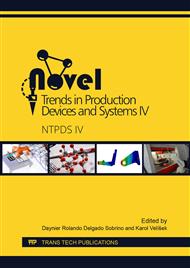[1]
F. Chen, G.Q. Tong, Z. Ma, X. Yue, The effects of welding parameters on the small scale resistance spot weldability of Ti-1Al-1Mn thin foils, Mater. Design. 102 (2016) 174-185.
DOI: 10.1016/j.matdes.2016.04.001
Google Scholar
[2]
P.S. Wei, T.H. Wu, Electrical contact resistance effect on resistance spot welding, Int. J Heat Mass Tran. 55 (2012) 3316-3324.
DOI: 10.1016/j.ijheatmasstransfer.2012.01.040
Google Scholar
[3]
R.D. Stout, The welding processes in relation to weldability, in: Weldability of steels, 4th edition, Welding Research Council, New York, 1987, p.20–22.
Google Scholar
[4]
H. Zhang, J. Senkara, Resistance welding: Fundamentals and Applications, second ed., Taylor & Francis Group, New York, (2011).
Google Scholar
[5]
S.R. Lee, Y.J. Choo, T.Y. Lee, M.H. Kim, S.K. Choi, A quality assurance technique for resistance spot welding using a neuro-fuzzy algorithm, J. Manuf. Syst. 20, (2001) 320–328.
DOI: 10.1016/s0278-6125(01)80051-0
Google Scholar
[6]
Ľ. Kaščák, J. Mucha, J. Slota, E. Spišák, Application of modern joining methods in car production, Oficyna Wydawnicza Politechniki Rzeszowskiej, Rzeszów, (2013).
Google Scholar
[7]
M. Eshragi, M.A. Tschopp, M.A. Zaeem, S.D. Felicelli, Effect of resistance spot welding parameters on weld pool properties in a DP600 dual-phase steel: A parametric study using thermomechanically-coupled finite element analysis, Mater. Design. 56 (2014).
DOI: 10.1016/j.matdes.2013.11.026
Google Scholar
[8]
H. Huh, S.B. Kim, J.H. Song, J.H. Lim, Dynamic tensile characteristics of TRIP-type and DP-type steel sheets for an auto-body, Int. J. Mech. Sci. 50 (2008) 918–931.
DOI: 10.1016/j.ijmecsci.2007.09.004
Google Scholar
[9]
S. Oliver, T.B. Jones, G. Fourlaris, Dual phase versus TRIP strip steels: Microstructural changes as a consequence of quasi-static and dynamic tensile testing, Mater. Charact. 58 (2007) 390–400.
DOI: 10.1016/j.matchar.2006.07.004
Google Scholar
[10]
Y. Abe, T. Kato, K. Mori, S. Nihsino, Mechanical clinching of ultra-high strength steel sheets and strength of joints Procedia Engineering, J. Mater. Process. Tech. 214 (2014) 2112-2118.
DOI: 10.1016/j.jmatprotec.2014.03.003
Google Scholar
[11]
J. Mucha, Ľ. Kaščák, E. Spišák, Joining the car-body sheets using clinching process with various thickness and mechanical property arrangements, Arch. Civ. Mech. Eng. 11 (2011) 135-148.
DOI: 10.1016/s1644-9665(12)60179-4
Google Scholar
[12]
C. Chen, S. Zhao, M. Cui, X. Han, X. Zhao, T. Ishida, Effects of geometrical parameters on the strength and energy absorption of the height-reduced joint, Int. J. Adv. Manuf. Tech. 90 (2017) 3533-3541.
DOI: 10.1007/s00170-016-9619-8
Google Scholar
[13]
C. Chen, S. Zhao, X. Han, M. Cui, X. Zhao, T. Ishida, Experimental investigation of the mechanical reshaping process for joining aluminum alloy sheets with different thicknesses, J. Manuf. Process. 26 (2017) 105-112.
DOI: 10.1016/j.jmapro.2017.01.015
Google Scholar
[14]
C.J. Lee, J.M. Lee, H.Y. Ryu, H.Y. Lee, K.H. Lee, B.M. Kim, D. C Ko, Design of hole-clinching process for joining of dissimilar materials – Al6061-T4 alloy with DP780 steel, hot-pressed 22MnB5 steel, and carbon fiber reinforced plastic, J. Mater. Process. Tech. 214 (2014).
DOI: 10.1016/j.jmatprotec.2014.03.032
Google Scholar
[15]
Y. Zhang, X. He, K. Zneg, L. Lei, F. Gu, A. Ball, Influence of heat treatment on mechanical properties of clinched joints in titanium alloy sheets, Int. J. Adv. Manuf. Technol. 91 (2017) 3349-3361.
DOI: 10.1007/s00170-017-0019-5
Google Scholar
[16]
B. Ali, B. Benabderrahmane, Finite element simulation of the hybrid clinch joining, Int. J. Adv. Manuf. Tech. 89 (2017) 439-449.
DOI: 10.1007/s00170-016-9094-2
Google Scholar
[17]
M. Israel, R. Mauermann, J. Schellnock, Thick sheet clinching – joining up to 20 mm total thickness, ASOE 2 (2013) 1-10.
Google Scholar
[18]
T. Jiang, Z. X Liu, P.C. Wang, Effect of aluminum pre-straining on strength of clinched galvanized SAE1004 steel-to-AA6111-T4 aluminum, J. Mater. Process. Tech. 215 (2015) 193-204.
DOI: 10.1016/j.jmatprotec.2014.08.016
Google Scholar
[19]
Ľ. Kaščák, E. Spišák, E. Spišáková, I. Gajdoš, Clinching – an Innovative Trend in Joining of Combined Materials in Car Body Production, Mater. Sci. Forum 818 (2015) 217-220.
DOI: 10.4028/www.scientific.net/msf.818.217
Google Scholar
[20]
J. Mucha, W. Witkowski, The clinching joints strength analysis in the aspects of changes in the forming technology and load conditions, Thin Wall. Struct. 82 (2014) 55-66.
DOI: 10.1016/j.tws.2014.04.001
Google Scholar
[21]
T.A. Barnes, I.R. Pashby, Joining techniques for aluminium spaceframes used in automobiles: part II adhesive bonding and mechanical fasteners, J. Mater. Process. Tech. 99 (2000) 72-79.
DOI: 10.1016/s0924-0136(99)00361-1
Google Scholar
[22]
R.F. Pedreschi, B.P. Sinha, An experimental study of cold formed steel trusses using mechanical clinching, Constr. Build. Mater. 22 (2008) 921-931.
DOI: 10.1016/j.conbuildmat.2006.12.014
Google Scholar
[23]
C. Ma, D.L. Chen, S.D. Bhole, G. Boudreau, A. Lee, E. Biro, Microstructure and fracture characteristics of spot-welded DP600 steel, Mater. Sci. Eng. 485 (2008) 334-346.
DOI: 10.1016/j.msea.2007.08.010
Google Scholar
[24]
X. Wan, Y. Wang, P. Zhang, Modelling the effect of welding current on resistance spot welding of DP600 steel, J. Mater. Process. Tech. 214 (2014) 2723-2729.
DOI: 10.1016/j.jmatprotec.2014.06.009
Google Scholar
[25]
V.H. Baltazar Hernandez, M.L. Kuntz, M.I. Khan, Y. Zhou, Influence of microstructure and weld size on the mechanical behaviour of dissimilar AHSS resistance spot welds, Sci. Technol. Weld. Joi. 13 (2008) 769-776.
DOI: 10.1179/136217108x325470
Google Scholar
[26]
D.W. Zhao, Y.X. Wang, L. Zhang, P. Zhang, Effects of electrode force on microstructure and mechanical behaviour of the resistance spot welded DP600 joint, Mater. Design. 50 (2013) 72-77.
DOI: 10.1016/j.matdes.2013.02.016
Google Scholar


